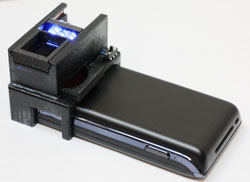
The device, which is attached to a cell phone, detects E. coli and the phone's camera is used to capture light emission images © Ozcan Research Lab at UCLA
US scientists have developed a device that, when attached to a mobile phone, can detect small amounts of Escherichia coli in liquid samples.
Outbreaks of E. coli poisoning still pose a threat to health, particularly in developing countries. As few as ten E. coli bacteria can cause serious ill health, so accurate and efficient detection devices are required to identify contaminated food and water. Existing detection devices are often expensive, complex and require large equipment unsuitable for field use.
There are over five billion mobile phones in the world and over 70% of these are in developing areas. Hongying Zhu and colleagues at the University of California, Los Angeles, developed a device able to take advantage of this abundant technology. Zhu commented that ‘our cell phone based platform would be very useful to bring advanced technologies to remote and resource poor locations’ adding that the phone provides ‘a ubiquitous platform for conducting advanced micro-analysis wherever cell phones work’.
Read the full story in Chemistry World
Link to journal article:
Quantum dot enabled detection of Escherichia coli using a cell-phone
Hongying Zhu, Uzair Sikora and Aydogan Ozcan
Analyst, 2012, Advance Article
DOI: 10.1039/C2AN35071H










